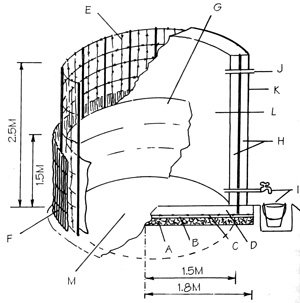Credits: Biovision-Infonet

(c) E. Nissen-Petersen, Kenya

(c) E. Nissen-Petersen, Kenya

(c) E. Nissen-Petersen, Kenya

(c) Natural Farming Network (Vukasin et al. 1995)
Short description: This datasheet describes methods to safely and hygienically store collected water, as well as how to build and repair water tanks, oil drums and jerry cans.
Introduction
Rains produce plenty of clean water running off roads, roofs, and rocks. This rainwater can be stored for the dry seasons when it is needed most. There are three types of storage, namely:
1) Storage in reservoirs, such as earth dams and ponds.
2) Storage in tanks
3) Storage in situ, such as in soil and sand.
Storage in reservoirs
If farmers want to have water during dry seasons, they should ‘harvest’ it during the annual four months with rain, just like Scandinavian farmers harvest and store sufficient fodder for their livestock during six months of summer to feed their livestock for the 6 winter months when the animals are tied up in stable.
There are many types of structures suitable for surface storage of harvested rainwater but nearly all of them lose water in one way or another, such as:
1)Evaporation. In hot climates it amounts to about 3 mm/day = 90 cm in a month. The solution for water tanks is to roof them but since earth dams cannot be roofed the evaporation losses cannot be reduced.
2) Increased consumption of water from tanks situated next to a house can be caused by neighbours begging for water and children forgetting to close the water tap. This can be avoided by extending the draw-off pipe into the house and locking the water tap.
3) Animals breaking into fenced earth dams are difficult to prevent. A profitable solution could be to charge the livestock owners a fee for watering their animals.
4) Seepage through the floor of earth dams is reduced by silt brought in by rainy seasons but siltation reduces the storage capacity of earth dams.
These, and other, losses of water during storage should be considered when planning designing a water project for either water for domestic user, livestock or irrigation. For example, since about half of the water stored in earth dams will disappear due to evaporation and seepage, the reservoirs should be built to store double the volume of water required.
Storage in Tanks

(c) E. Nissen-Petersen, Kenya
General guidelines for water storage in tanks
Fresh or purified water can quickly become re-contaminated because:
1) The containers used to store the water are not clean.
2) Unclean things are dipped into the water (this includes hands, clothes, etc.).
3) The water is not covered and so insects, dust or other foreign substances can enter the water. Chemically disinfected water can have a residual protection which will deal with light recontamination, but even this protection disappears in time.
Thus, to prevent recontamination, only clean storage containers should be used and the water should be protected from any contact with objects other than the container.
The container requires periodic emptying, washing, and rinsing with scalding or heavily chlorinated water, to prevent the growth of biofilms.
The storage container should be equipped with a practical mechanism to retrieve the water, e.g. a tap (spigot) especially when bigger containers are used.Storing water for later use is more difficult than collecting water.
Ways to store water for household use include tanks or cisterns. Tanks can be constructed of bricks, masonry, corrugated steel sheets, or reinforced concrete, either above ground or below ground.
The capacity of the tanks should be determined based on the run-off expected and on the estimated daily use. Before the rain starts, the tank or storage area should be clean.
The first direct flush of rainwater should be directed away from the storage, since it contains the dirt from the catchment area. Cover the tank to prevent evaporation from the sun, keep the water surface clean, and prevent mosquitos from entering the water.
The storage tank should be placed near the place of usage, e.g. the kitchen. Furthermore, there should be a possibility to redirect the overflow or spilled water to a nearby garden or orchard. Storage tanks and reservoirs can become breeding places for malaria mosquitos.
The open water area can be used as breeding places for the mosquitos even in the dry season, when malaria transmission is normally decreased.
The open water surface should not be accessible to mosquitoes: the tanks should be covered and all other inlets (taps, ventilation pipes) screened with mosquito-proof mesh. It should also be avoided that breeding sites are established downstream of the overflow.
Storage in Situ
The cheapest method of storing rainwater is to recharge shallow ground water aquifers, also called in situ storage, during rainy seasons and draw the water by means of hand-dug wells throughout the year. However, this cheap method may not always succeed because:
1. The water may seep deep into the underground where it becomes salty and unfit for human consumption
2. The water may be too deep for shallow wells and require investment in expensive boreholes and pumps.
3. The water may not be found in the underground.